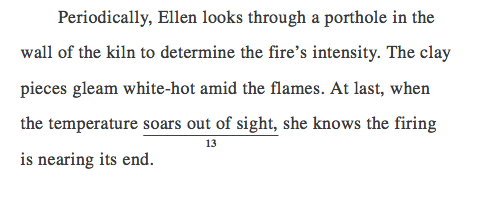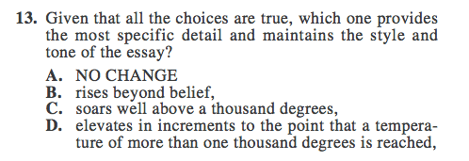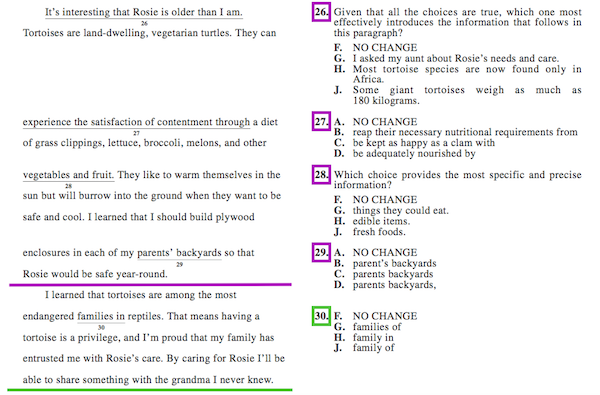
The ACT English can be overwhelming. There are so many questions! And they're mostly just underlined text: what are they even asking? Of course, that confusion is the whole point: it's what makes this part of the test hard.
What does that mean for you? Because the ACT test writers rely on your confusion about the format to confuse you, the questions themselves usually aren't that difficult.
In order to excel on the English section of the ACT, you first need to understand how it's organized—if you're not yet clear on that, take a look at our post laying out exactly what's tested on the ACT English. Once you know the basics of how this section of the test work, you just have to learn how to approach it. Do that, and you’ll find that the English section is surprisingly simple!
There are five key points you need to understand about the ACT English:
- ACT English Isn't the Same as High School English
- The ACT Tests a Limited Set of English Concepts
- You Always Need a Plan
- You Can Use the Format to Your Advantage
- Rushing Will Hurt Your Score
Let's go through these one at a time.
Feature Image Credit: CollegeDegrees360
#1: ACT English Isn't the Same as Everyday Informal English
A lot of students believe that since they speak English the English section should be easy, right? Not quite. Even students who excel with writing and grammar in school can struggle with the ACT English because the test has its own logic. The ACT will sometimes consider sentences that would be fine with your English teacher wrong, while some of the constructions that are correct on the test would make your teacher cringe.
Answers That Sound Right but Are Actually Wrong
A common strategy on the ACT English is to "listen" for errors and pick the answer that "sounds" correct. This approach is certainly helpful for picking out some of the more obvious errors, but the test will use it against you. There are a lot of questions about constructions that we routinely misuse in spoken English—they may sound right, but they're actually wrong.
Take "should of" for example:
If he didn't want to be late, he should of taken the shorter route.
Sounds fine! But this is actually a misspelling of "should've," the contraction of "should have." If you say both "should've" and "should of" out loud, you'll notice that they sound almost identical. The correct version of the sentence is:
If he didn't want to be late, he should've taken the shorter route.
I don't recommend relying on "listening" for errors, but if you do plan to do so (and even if you don't) make sure to study the errors that we routinely make when speaking: pronouns, subject-verb agreement, word choice, and commas.
Unfamiliar Grammar Rules
Even more confusing are the ACT English's unique grammar rules, many of which will be completely new to you or even contradict what you've been taught in school. With that in mind, the most important advice I can give you about the ACT English is to approach the test on its own terms.
For example, a common error I see students make is assuming that the most formal answer is the best one. In school you're expected to use very formal English for essays and assignments, so shouldn't the ACT want the same thing? But it doesn't quite work that way, as you'll see in this example.


This question asks for an answer that does two things: "provides the most specific detail" and "maintains the style and tone of the essay." Choices A and B can be ruled out because neither one provides specific details.
That leaves answers C and D, which both specify that the kiln's temperature rises above a thousand degrees—the difference between them is one of tone. If you're looking for the most formal answer, D seems correct; however, that answer is unnecessarily wordy and doesn't fit with the more conversational style of the passage itself.
As such, C, which provides the relevant detail in a tone that fits into the passage, is the correct answer.
You can't assume that the ACT English follows the same rules that you've been taught in school; instead, you have to understand what the test itself wants you to know.

The ACT English is not like this (© David Shankbone)
#2: The Rules for ACT English May Be Weird, but There Aren't That Many of Them
If, as I just told you, a lot of what you already know about English is useless on the ACT, then what do you need to know? In short, you must know the specific set of rules that the ACT considers important, as well as how those rules are tested on the ACT.
Well, luckily, the types of questions on the ACT English are extremely limited, which makes this section of the test surprisingly easy to study for. These questions fall into two categories: usage and mechanics (~55%) and rhetorical skills (~45%). I'm not going to detail all the concepts you need to know—take a look at our complete guide to ACT grammar rules for that—instead, I'm going to help you start analyzing how the ACT writers design questions.
Remember that the ACT tests concepts in context, so it's less important to know the names of terms of the reason behind rules than to understand how to spot and correct errors.
Usage and Mechanics
The usage and mechanics questions are divvied up into three categories:
- sentence structure, which includes sentence fragments, run-ons, misplaced modifiers, and parallelism
- grammar and usage, which includes subject-verb agreement, verb tense, pronoun usage, and adjectives and adverbs
- punctuation, which includes commas, apostrophes, dashes, colons, and semi-colons.
To do well on the usage and mechanics, you have to both know the grammar rules as defined by the ACT and understand how to spot those errors in practice. That means studying the concepts—see our in-depth guide to the ACT English or our guide to the best ACT books—and then drilling yourself with real ACT practice passages, which you can find in the Official Guide to the ACT or online.
Because the ACT is standardized, these topics are tested in certain defined ways that you will see again and again. For example, a lot of verb tense questions are actually subject-verb agreement questions in disguise: all the answers are in different forms, but only one is correctly conjugated.
As you practice, keep an eye out for these types of tricks—the better you get at understanding the logic of the questions, the higher your score will be.
Rhetorical Skills
Rhetorical skills questions are the ones that really confuse a lot of students, since they aren't even remotely similar to the test questions you see in school. The ACT categorizes them in to three groups:
- organization, which covers transitions and sentence and paragraph order
- strategy, which covers sentence additions and main idea questions
- style, which covers redundancy and word choice.
Though each type of rhetorical skills question has its own quirks, they're almost all governed by two basic principles:
- All prose should be as clear as possible.
- You must answer the question you're being asked.
That may sound like gibberish, so let's break it down.
When I say that you should prioritize clarity in picking answers, I mean that you want to focus on finding the clearest answer, i.e. the choice that provides all of the necessary information and nothing more, in the most straightforward way possible. Phrasing questions will try to confuse you with extra words that sound smart or important: don't let them fool you!
My second point may seem superfluous (of course you have to answer the question!), but it's just as important as the first. On the ACT English, the test items that involve actual questions will ask you for very specific things. You must read these questions carefully and pick the answer that best fits the criteria they lay out.
Let's look at an actual rhetorical skills question to see how to apply these ideas.

None of these answers involve a lot of extra words, but C and D are both phrased slightly confusingly, so we can probably rule those out.
Next, let's look at what exactly the question is asking for: a specific and vivid description of the underwater terrain. Now we can definitely be sure that C and D are wrong—they're both quite vague. Moreover, we can see that A must be the correct answer, since it's the only one that gives a sense of what the underwater scene actually looks like.
Now that we've covered how the ACT English is different from what you might expect, let's cover the tools you need to tackle this admittedly weird test successfully.
#3: Always Have a Plan of Attack
Because the format of the ACT English is so different from the tests you take in school, it's easy to get confused or overwhelmed and end up approaching the passages haphazardly, looking at each underlined section individually. Don't do this! Because the test is designed to test grammar concepts in context, looking at only the underlined portions will cause you to miss questions.
Instead, you want to have a strategy for how you approach passages that you use every time you take the test, whether it's for practice or the real thing. Different methods work best for different people, and you'll have to decide what makes the most sense for you. However, every good strategy shares one vital principle: no matter where in a sentence the underlined section appears, you must always read to the end of the sentence. If you don't do this, it will hurt your score—a lot.
For a full breakdown of the pros and cons of different strategies, take a look at our post onthe best way to approach the ACT English passages. Below I've included a quick take on two possible approaches.
The Best Strategy for Approaching ACT English Passages
Like I said before, every student has their own way of approaching things. However, I've found that the strategy that best minimizes the potential for misunderstanding context is to first read each paragraph and then go back and answer all the questions about that paragraph. Let's walk through how this works in an actual ACT Passage.

In this example, you start by reading the first paragraph, until the purple line. Then you answer the questions that are marked with purple boxes. You can see how having read the entire paragraph makes answering question 26, which asks for the sentence that "most effectively introduces the information that follows," much easier.
You'll still need to be especially careful with questions 27 and 28, since they appear in the same sentence—in these cases, make sure to look at both underlined portions and consider whether the answer to one will affect the answer to the other.
Once you've completed the two-step process for that paragraph, you move on to the next one. Read down to the green line, and then answer the question marked in green.
On a real ACT English section, you would repeat this process for each paragraph in each passage.
Strategy for Those who Struggle with Time
Though the above strategy is ideal, as it gives the clearest understanding of the context for each question, you may find that it's too time consuming. If you are running out of time on the English section with more than a couple of questions of left, you may want to focus more closely on the underlined portions of the passage.
In this strategy, you read only the sentences that contain underlined portions (you still have to read the entire sentence, though), answering the specific questions as you go, and then going back to any big picture questions at the end. You can see how this approach works in the example below.

26 is a big picture question, so we skip the blue highlighted portion, and go straight to pink sentence. We read that and answer 27 and 28. Next, we read the yellow sentence, answer 29, read the green sentence, and answer 30. Finally, we return to the blue sentence and answer 26. For a full passage, you follow the same pattern but for all 15 questions.
This strategy can work, but it's not nearly as reliable as the first one. I don't recommend it if you're shooting for a score higher than a 25.
(In case you're curious, the correct answers for the questions above are as follows: 26. G, 27. D, 28. F, 29. A, 30. G)
 Remember: always have a plan!
Remember: always have a plan!
#4: Use the Structure of the Test to Your Advantage
Once you master your approach to the passages, you'll need to learn how the ACT English questions work. The best way to do that is just to look at, practice with, and analyze as many real ACT questions as possible. Keep in mind that the test is multiple choice and consider how you can use that to your advantage.
Here are a few tips to get you started.
Strategy: Consider How the Answer Choices are Different from Each Other
Let's say you look at an underlined portion and don't see anything wrong: you should just bubble A (for no change) and move on, right? Not quite. Just because you don't recognize the error immediately doesn't mean there isn't one.
Instead, try looking at the answers. What's the difference (or differences) between them? Once you figure that out, you'll know what kind of question you're dealing with—whether it's a subject-verb agreement or idiomatic usage question, for example. Let's look at some examples:

Even without knowing the context, we can see that this a question about punctuation. Looking back at the sentence, you could then determine what factors will affect the correct punctuation here: maybe there's a dash earlier in the sentence and you need another one to properly punctuate a interjection or maybe this punctuation mark falls between two independent clauses, making the semicolon correct.
Next, we've got a trickier case:

In this example, we can see that there are two questions at issue: whether "therefore" or "in addition" is the correct transition and whether a period or a comma is the correct punctuation. With two concept questions like this, you can narrow down choices based on one of the issues, even if you aren't sure about the other one.
Strategy: Don't Get Too Attached to Your Own Idea of the Answer
We've talked about what to do when you aren't immediately sure what's going on with a question, but what about the times when you immediately know what's wrong and how to fix it? For the most part, those occasions are the best case scenarios—you should still read all the answer choices and double check to make sure you aren't falling into any traps, like failing to read to the end of a sentence or missing a "not" in the question, but usually you'll be able to quickly determine the right choice and move on.
However, there will be times, especially when dealing with the rhetorical skills question, that you come up with the perfect answer only to find that there's no choice even remotely similar to it. Don't panic! Think about what the error is, rather than what would be correct, and eliminate any answers with the same mistake. Then try to narrow down the rest of the choices. Once you've got it down to one choice, plug that back into the sentence and see if it makes sense.
Strategy: Eliminate Identical Answers
This is a pretty simple strategy, but a lot of students find it really helpful: If two answers are functionally identical, they must both be wrong.
Think about it this way: if you have a transition question and "Furthermore" and "Moreover" are both answer choices, how can you choose between them? You can't, because they mean the same thing. As such, both answers must be wrong.
The exception to this rule is if there are more than two answers that are all the same. In that case, you've probably missed the part of the question that says "Which of the following would NOT be acceptable?" Go back and check.
Keep an eye out for these kinds of patterns as you study—they're invaluable for conquering the weird world of the ACT English!
 This is good advice for every section of the ACT!
This is good advice for every section of the ACT!
#5: Don't Rush!
After reading all this advice, you may be wondering how you will possibly get through the whole English section of the ACT in just 45 minutes. After all, it includes five passages and 75 questions, which is quite a lot.
However, if you try out a couple of practice sections, you'll find that they go much faster than you expect. In fact, many students make a lot of careless mistakes because they're rushing to get through the test and then end up with time left over at the end.
If you have more than one or two minutes left at the end of the English section and are missing more than a handful of questions, you're moving too fast.
Even if you do find yourself running out of time, it may not benefit you to speed up. Rushing will always hurt your score. You may be better off guessing on some of the questions at the very end or skipping some of the time consuming big picture questions than you would be struggling to get to every single question in the allotted time.
What's Next?
Now that you understand the big picture of the English ACT, drill into some specific grammar topics, starting with our complete guide to commas.
Aiming for that elusive perfect 36? Try our guide to getting a 36 on the ACT English from a perfect scorer.
Or maybe after that you're considering switching to the SAT? Make sure you understand the differences between ACT English and SAT Writing first.
Want to improve your ACT score by 4 points?
Check out our best-in-class online ACT prep program. We guarantee your money back if you don't improve your ACT score by 4 points or more.
Our program is entirely online, and it customizes what you study to your strengths and weaknesses. If you liked this English lesson, you'll love our program. Along with more detailed lessons, you'll get thousands of practice problems organized by individual skills so you learn most effectively. We'll also give you a step-by-step program to follow so you'll never be confused about what to study next.
Check out our 5-day free trial:
Have friends who also need help with test prep? Share this article!

Alex is an experienced tutor and writer. Over the past five years, she has worked with almost a hundred students and written about pop culture for a wide range of publications. She graduated with honors from University of Chicago, receiving a BA in English and Anthropology, and then went on to earn an MA at NYU in Cultural Reporting and Criticism. In high school, she was a National Merit Scholar, took 12 AP tests and scored 99 percentile scores on the SAT and ACT.


































 Holly R.
Holly R.